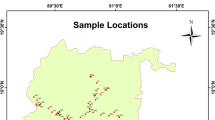Abstract
The present study highlights uranium levels, associated health effects, and physicochemical properties of ground water samples collected from Rajnandgaon District of Chhattisgarh State, Central India. Uranium concentrations of ground water samples are found to exceed than 30 µg/L (United States Environmental Protection Agency and World Health Organisation recommended limit) at two villages in summer and at one village in winter while it is found higher than 60 µg/L (Atomic Energy Regulatory Board, Department of Atomic Energy, India recommended limit) at only one village in summer. Correlation analysis between uranium and physicochemical parameters suggest that Ca2+ ion and total alkalinity play an important role in uranium contamination of ground water.





Similar content being viewed by others
References
Adithya V, Chidambaram S, Tirumalesh K, Thivya C, Thilagavathi R, Prasanna M (2016) Assessment of sources for higher Uranium concentration in ground waters of the Central Tamilnadu, India. In: IOP conference series: materials science and engineering, vol 121, Institute of Physics Publishing. https://doi.org/10.1088/1757-899x/121/1/012009
USEPA (United States Environmental Protection Agency) (2000) National primary drinking water regulation, radionuclides. Final Rule, 40 CFR Parts 9, 141, and 142, pp 76708–76712
WHO (World Health Organisation) (2011) Guidelines for drinking-water quality recommendations, vol 1, 4th edn. WHO, Geneva, p 515
AERB (Atomic Energy Regulatory Board) (2004) Drinking water specifications in India. Department of Atomic Energy, Government of India, Mumbai
Homma-Takeda S, Kitahara K, Suzuki K, Blyth BJ, Suya N, Konishi T, Terada Y, Shimada Y (2015) Cellular localization of uranium in the renal proximal tubules during acute renal uranium toxicity. J Appl Toxicol 35(12):1594–1600
Kitahara K, Numako C, Terada Y, Nitta K, Shimada Y, Homma-Takeda S (2017) Uranium XAFS analysis of kidney from rats exposed to uranium. Journal of Synchrotron Radiation 24(2):456–462
Thun JM, Baker B, Steenland K, Smith BA, Halperin W, Berl T (1985) Renal toxicity in uranium mill workers. Scand J Work Environ Health 11(2):83–90
Vicente L, Quiros Y, Barriocanal F, Novoa J, Hernandez F, Morales A (2010) Nephrotoxicity of uranium: pathophysiological, diagnostic and therapeutic perspectives. Toxicol Sci 118(2):324–347
CGWB (Central Ground Water Board) (2012) Ground water information Rajnandgaon District, Chhattisgarh available from http://cgwb.gov.in/District_Profile/Chhatisgarh/Rajnandgaon.pdf
USEPA (United States Environmental Protection Agency) (1991) Risk assessment guidance for superfund: human health evaluation manual, vol 1 (Part B, Development of risk-based preliminary remediation goals), Publication 9285.7-01 B, Office of Emergency and Remedial Response, Washington, DC
USEPA (United States Environmental Protection Agency) (1997) Health effects assessment summary tables (HEAST) FY-1997 update. Office of Emergency and Remedial Response, Washington, DC
Giri S, Jha VN (2012) Risk assessment (chemical and radiological) due to intake of uranium through the ingestion of drinking water around two proposed uranium mining areas, Jharkhand. India. Radioprotection 47(4):543–551
HDR (Human Development Report) (2009) National resource centre for urban poverty and all India institute of local self Government. HDR, Mumbai
Jain SC, Metha SC, Kumar B, Reddy AR, Nagaratnam A (1995) Formulation of reference Indian adult anatomic and physiological data. Health Phys 68(4):509–522
Dang HS, Jaiswal DD, Parameswaran M, Krishnamony S (1994) Physical, anatomical, physiological and metabolic data for reference Indian Man—a proposal, BARC/1994/E/043, Radiation Protection and Dosimetry, India
USEPA (United States Environmental Protection Agency) (1989) IRIS (Integrated Risk Information System). Office of Health and Environmental Assessment, Washington, DC
Maiti SK (2004) Handbook of methods in environmental studies: water and waste water analysis, vol 1, 2nd edn. ABD Publishers, Jaipur
Taras MJ, Greenberg AE, Hoak RD, Rand MC (1971) Standard methods for the examination of water and wastewater, 13th edn. American Public Health Association, Washington, DC
Horton RK (1965) An index number system for rating water quality. Journal of the Water Pollution Control Federation 37(3):300–305
Brindha K, Elango L (2013) Occurrence of uranium in groundwater of a shallow granitic aquifer and its suitability for domestic use in southern India. J Radioanal Nucl Chem 295:357–367
Singh S, Malhotra R, Kumar J, Singh B, Singh L (2001) Uranium analysis of geological samples, water and plants from Kulu Area Himachal Pradesh India. Radiat Meas 34:427–431
Birke M, Rauch U, Lorenz H, Kringel R (2010) Distribution of uranium in German bottled and taps water. J Geochem Explor 107:272–282
Sparovek RBM, Fleckenstein J, Schnug E (2013) Issues of uranium and radioactivity in natural mineral waters. Landbauforschung Volkenrode 4(51):149–157
Smith B, Powell AE, Milodowski AE, Hards VL, Hutchins MG, Amro A, Gedeon R, Kilani S, Scrivens SM, Galt V (2000) Identification, investigation and remediation of ground water containing elevated levels of uranium-series radionuclides: a case study from the Eastern Mediterranean. In: Panayides L, Xenophotons C, Malpas J (eds) Proceedings of the third international conference on the geology of the Eastern Mediterranean, Nicosia, Cyprus. World Health Organisation, Geneva (WHO/SDE/PHE/01.01)
Bajwa BS, Kumar S, Singh S, Sahoo SK, Tripathi RM (2017) Uranium and other heavy toxic elements distribution in the drinking water samples of SW-Punjab India. Journal of Radiation Research and Applied Sciences 10:13–19
BIS (Bureau of Indian Standards) (2012) Drinking water specification. Bureau of Indian standards, New Delhi (IS 10500)
Patel KS, Sahu BL, Dahariya NS, Bhatia A, Patel RK, Matini L, Sracek O, Bhattacharya P (2017) Groundwater arsenic and fluoride in Rajnandgaon District, Chhattisgarh, north-eastern India. Applied Water Science 7:1817–1826
Chatterji C, Raziuddin M (2002) Determination of water quality index of a degraded river in Asanol industrial area, Raniganj, Burdwan, West Bengal. Nat Environ Pollut Technol 1(2):181–189
Acknowledgements
Authors are thankful to BRNS [36(4)/14/90/2014-BRNS] for funding this research work. We are also thankful to Bhilai Institute of Technology (BIT) for providing lab facility.
Author information
Authors and Affiliations
Corresponding author
Additional information
Publisher's Note
Springer Nature remains neutral with regard to jurisdictional claims in published maps and institutional affiliations.
Rights and permissions
About this article
Cite this article
Diwan, V., Sar, S.K., Biswas, S. et al. Uranium in ground water of Rajnandgaon District of Central India. J Radioanal Nucl Chem 321, 293–302 (2019). https://doi.org/10.1007/s10967-019-06568-9
Received:
Published:
Issue Date:
DOI: https://doi.org/10.1007/s10967-019-06568-9




